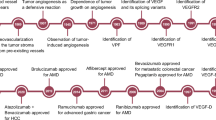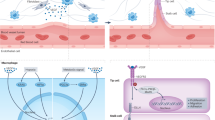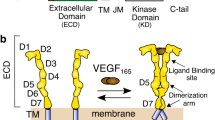Abstract
Although VEGFR-3 deficiency disrupts blood vascular development during early embryogenesis, the underlying mechanism was not clear. To characterize its function in angiogenesis and lymphangiogenesis, we employed two genetically modified mouse models in this study, targeting the coding region for the ligand-binding domain (Vegfr3ΔLBD) or the tyrosine kinase domain with an inactivation point mutation (Vegfr3TKmut). We show that lymphatic growth was disrupted in Vegfr3ΔLBD/ΔLBD and Vegfr3TKmut/TKmut mice, but blood vessels developed normally in both embryo and yolk sac. Interestingly, in Vegfr3ΔLBD/ΔLBD but not Vegfr3TKmut/TKmut mice, lymph sac was present but there was lack of lymphangiogenic sprouting. We further demonstrate that both the wild-type and mutant forms of VEGFR-3 could form heterodimers with VEGFR-2, and decreased the level of phospho-VEGFR-2 and the downstream phospho-Erk1/2 in endothelial cells when they were treated with VEGF-A. These findings indicate that signaling mediated via VEGFR-3 activation by its cognate ligands (VEGF-C/-D) is not required for angiogenesis, and that VEGFR-3 may play a role in this process by modulating VEGFR-2-mediated signals.
Similar content being viewed by others
Log in or create a free account to read this content
Gain free access to this article, as well as selected content from this journal and more on nature.com
or
References
Adams RH, Alitalo K . Molecular regulation of angiogenesis and lymphangiogenesis. Nat Rev Mol Cell Biol 2007; 8:464–478.
Coultas L, Chawengsaksophak K, Rossant J . Endothelial cells and VEGF in vascular development. Nature 2005; 438:937–945.
De Val S, Black BL . Transcriptional control of endothelial cell development. Dev Cell 2009; 16:180–195.
Wigle JT, Oliver G . Prox1 function is required for the development of the murine lymphatic system. Cell 1999; 98:769–778.
Oliver G, Detmar M . The rediscovery of the lymphatic system: old and new insights into the development and biological function of the lymphatic vasculature. Genes Dev 2002; 16:773–783.
Francois M, Caprini A, Hosking B, et al. Sox18 induces development of the lymphatic vasculature in mice. Nature 2008; 456:643–647.
Li X, Claesson-Welsh L, Shibuya M . VEGF receptor signal transduction. Methods Enzymol 2008; 443:261–284.
Ferrara N, Gerber HP, LeCouter J . The biology of VEGF and its receptors. Nat Med 2003; 9:669–676.
Joukov V, Sorsa T, Kumar V, et al. Proteolytic processing regulates receptor specificity and activity of VEGF-C. EMBO J 1997; 16:3898–3911.
Stacker SA, Stenvers K, Caesar C, et al. Biosynthesis of vascular endothelial growth factor-D involves proteolytic processing which generates non-covalent homodimers. J Biol Chem 1999; 274:32127–32136.
Lamont RE, Childs S . MAPping out arteries and veins. Sci STKE 2006; 2006:pe39.
Makinen T, Jussila L, Veikkola T, et al. Inhibition of lymphangiogenesis with resulting lymphedema in transgenic mice expressing soluble VEGF receptor-3. Nat Med 2001; 7:199–205.
Karkkainen MJ, Ferrell RE, Lawrence EC, et al. Missense mutations interfere with VEGFR-3 signalling in primary lymphoedema. Nat Genet 2000; 25:153–159.
He Y, Kozaki K, Karpanen T, et al. Suppression of tumor lymphangiogenesis and lymph node metastasis by blocking vascular endothelial growth factor receptor 3 signaling. J Natl Cancer Inst 2002; 94:819–825.
Kaipainen A, Korhonen J, Mustonen T, et al. Expression of the fms-like tyrosine kinase 4 gene becomes restricted to lymphatic endothelium during development. Proc Natl Acad Sci USA 1995; 92:3566–3570.
Valtola R, Salven P, Heikkila P, et al. VEGFR-3 and its ligand VEGF-C are associated with angiogenesis in breast cancer. Am J Pathol 1999; 154:1381–1390.
Clarijs R, Schalkwijk L, Hofmann UB, Ruiter DJ, de Waal RM . Induction of vascular endothelial growth factor receptor-3 expression on tumor microvasculature as a new progression marker in human cutaneous melanoma. Cancer Res 2002; 62:7059–7065.
Kubo H, Fujiwara T, Jussila L, et al. Involvement of vascular endothelial growth factor receptor-3 in maintenance of integrity of endothelial cell lining during tumor angiogenesis. Blood 2000; 96:546–553.
Tammela T, Zarkada G, Wallgard E, et al. Blocking VEGFR-3 suppresses angiogenic sprouting and vascular network formation. Nature 2008; 454:656–660.
Dumont DJ, Jussila L, Taipale J, et al. Cardiovascular failure in mouse embryos deficient in VEGF receptor-3. Science 1998; 282:946–949.
Hamada K, Oike Y, Takakura N, et al. VEGF-C signaling pathways through VEGFR-2 and VEGFR-3 in vasculoangiogenesis and hematopoiesis. Blood 2000; 96:3793–3800.
Haiko P, Makinen T, Keskitalo S, et al. Deletion of vascular endothelial growth factor (VEGF-C) and VEGF-D is not equivalent to VEGFR-3-null in mouse embryos. Mol Cell Biol 2008; 28:4843–4850.
Lakso M, Pichel JG, Gorman JR, et al. Efficient in vivo manipulation of mouse genomic sequences at the zygote stage. Proc Natl Acad Sci USA 1996; 93:5860–5865.
Banerji S, Ni J, Wang SX, et al. LYVE-1, a new homologue of the CD44 glycoprotein, is a lymph-specific receptor for hyaluronan. J Cell Biol 1999; 144:789–801.
Gordon EJ, Gale NW, Harvey NL . Expression of the hyaluronan receptor LYVE-1 is not restricted to the lymphatic vasculature; LYVE-1 is also expressed on embryonic blood vessels. Dev Dyn 2008; 237:1901–1909.
Karkkainen MJ, Saaristo A, Jussila L, et al. A model for gene therapy of human hereditary lymphedema. Proc Natl Acad Sci USA 2001; 98:12677–12682.
Zhang X, Groopman JE, Wang JF . Extracellular matrix regulates endothelial functions through interaction of VEGFR-3 and integrin alpha5beta1. J Cell Physiol 2005; 202:205–214.
Karpanen T, Heckman CA, Keskitalo S, et al. Functional interaction of VEGF-C and VEGF-D with neuropilin receptors. FASEB J 2006; 20:1462–1472.
Nilsson I, Bahram F, Li X, et al. VEGF receptor 2/-3 heterodimers detected in situ by proximity ligation on angiogenic sprouts. EMBO J 2010; 29:1377–1388.
Karkkainen MJ, Haiko P, Sainio K, et al. Vascular endothelial growth factor C is required for sprouting of the first lymphatic vessels from embryonic veins. Nat Immunol 2004; 5:74–80.
He Y, Rajantie I, Pajusola K, et al. Vascular endothelial cell growth factor receptor 3-mediated activation of lymphatic endothelium is crucial for tumor cell entry and spread via lymphatic vessels. Cancer Res 2005; 65:4739–4746.
Hiratsuka S, Minowa O, Kuno J, Noda T, Shibuya M . Flt-1 lacking the tyrosine kinase domain is sufficient for normal development and angiogenesis in mice. Proc Natl Acad Sci USA 1998; 95:9349–9354.
Dixelius J, Makinen T, Wirzenius M, et al. Ligand-induced vascular endothelial growth factor receptor-3 (VEGFR-3) heterodimerization with VEGFR-2 in primary lymphatic endothelial cells regulates tyrosine phosphorylation sites. J Biol Chem 2003; 278:40973–40979.
Wang JF, Zhang XF, Groopman JE . Stimulation of beta 1 integrin induces tyrosine phosphorylation of vascular endothelial growth factor receptor-3 and modulates cell migration. J Biol Chem 2001; 276:41950–41957.
Galvagni F, Pennacchini S, Salameh A, et al. Endothelial cell adhesion to the extracellular matrix induces c-Src-dependent VEGFR-3 phosphorylation without the activation of the receptor intrinsic kinase activity. Circ Res 2010; 106:1839–1848.
Xu Y, Yuan L, Mak J, et al. Neuropilin-2 mediates VEGF-C-induced lymphatic sprouting together with VEGFR3. J Cell Biol 2010; 188:115–130.
Liu P, Jenkins NA, Copeland NG . A highly efficient recombineering-based method for generating conditional knockout mutations. Genome Res 2003; 13:476–484.
Nagy A, Rossant J, Nagy R, Abramow-Newerly W, Roder JC . Derivation of completely cell culture-derived mice from early-passage embryonic stem cells. Proc Natl Acad Sci USA 1993; 90:8424–8428.
Farley FW, Soriano P, Steffen LS, Dymecki SM . Widespread recombinase expression using FLPeR (flipper) mice. Genesis 2000; 28:106–110.
Karpanen T, Egeblad M, Karkkainen MJ, et al. Vascular endothelial growth factor C promotes tumor lymphangiogenesis and intralymphatic tumor growth. Cancer Res 2001; 61:1786–1790.
Baudin B, Bruneel A, Bosselut N, Vaubourdolle M . A protocol for isolation and culture of human umbilical vein endothelial cells. Nat Protocol 2007; 2:481–485.
Takahashi T, Yamaguchi S, Chida K, Shibuya M . A single autophosphorylation site on KDR/Flk-1 is essential for VEGF-A-dependent activation of PLC-gamma and DNA synthesis in vascular endothelial cells. EMBO J 2001; 20:2768–2778.
Tammela T, He Y, Lyytikka J, et al. Distinct architecture of lymphatic vessels induced by chimeric vascular endothelial growth factor-C/vascular endothelial growth factor heparin-binding domain fusion proteins. Circ Res 2007; 100:1468–1475.
Acknowledgements
We thank Dr Lena Claesson-Welsh (Uppsala University), and PIs of Model Animal Research Center (MARC, Nanjing University) for the helpful discussion about the work, and Yanlan Cao, Wenting Shi and all the staff in the MARC Animal facility of Nanjing University for excellent technical assistance. This work was financially supported by grants from the National Natural Science Foundation of China (30771069, 30671038, and 30930028), the Ministry of Science and Technology of China (2006CB943500), and the Ministry of Education of China (NCET: Program for New Century Excellent Talents in University).
Author information
Authors and Affiliations
Corresponding author
Additional information
( Supplementary information is linked to the online version of the paper on Cell Research website.)
Supplementary information
Supplementary information, Figure S1
VEGFR-3 targeting strategy and vascular analysis in somite regions. (PDF 202 kb)
Supplementary information, Figure S2
Analysis of VEGFR-3 expression in blood vessels. (PDF 690 kb)
Supplementary information, Figure S3
Analysis of receptor autophosphorylation of three different forms of VEGFR-3 (VEGFR-3WT, VEGFR-3Tkmut, and VEGFR-3ΔLBD). (PDF 104 kb)
Supplementary information, Figure S4
Analysis of somite vascular growth in Vegfr3TKmut/TKmut mice. (PDF 150 kb)
Supplementary information, Figure S5
Analysis of retina and tumor angiogenesis in Vegfr3WT/TKmut mice. (PDF 233 kb)
Rights and permissions
About this article
Cite this article
Zhang, L., Zhou, F., Han, W. et al. VEGFR-3 ligand-binding and kinase activity are required for lymphangiogenesis but not for angiogenesis. Cell Res 20, 1319–1331 (2010). https://doi.org/10.1038/cr.2010.116
Received:
Revised:
Accepted:
Published:
Issue date:
DOI: https://doi.org/10.1038/cr.2010.116
Keywords
This article is cited by
-
Sinusoidal and lymphatic vessel growth is controlled by reciprocal VEGF-C–CDH5 inhibition
Nature Cardiovascular Research (2022)
-
PEDF inhibits lymphatic metastasis of nasopharyngeal carcinoma as a new lymphangiogenesis inhibitor
Cell Death & Disease (2021)
-
Brain expression of the vascular endothelial growth factor gene family in cognitive aging and alzheimer’s disease
Molecular Psychiatry (2021)
-
Vascular anomalies of the head and neck: diagnosis and treatment
Pediatric Radiology (2021)
-
Lymphoangiocrine signals promote cardiac growth and repair
Nature (2020)



